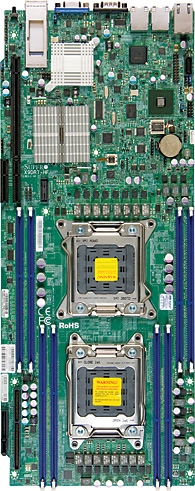The Xeon E5-2600: Dual Sandy Bridge for Servers
by Johan De Gelas on March 6, 2012 9:27 AM EST- Posted in
- IT Computing
- Virtualization
- Xeon
- Opteron
- Cloud Computing
Supermicro's Latest Twin
We got a sneak peak at the Supermicro's brand new Twin 2U server: the SYS-6027TR-D71FRF. The 2U chassis has two dual Xeon E5 based servers inside that are fed by two fully redundant 1280W PSUs (at 180-230V, 1000W at 100-140V).
The two servers are held in place using screwless clips.
You get the density of a 1U server without needing four PSUs for redundancy and without the very power hungry 40 mm fans. Indeed, using only 2 PSUs and 80 mm fans should save quite a bit of power compared to 2 1U servers. Last time we measured, the Twin servers consumed 6% less power than the best 1U servers on the market.
At the same time, the expansion capabilities are better: you get two full height and one half height PCIe 3.0 (!) x16 (x8 electrical) slots. The only disadvantage is that you only get 4 DIMM slots per CPU, which generally limits each server to about 128 GB of RAM (8 x 16 GB) unless you go with expensive 32 GB LR-DIMMS for a total of 256 GB. Therefore this server is probably better for HPC workloads than for memory intensive virtualization and database applications.
This new Twin server also features FDR InfiniBand interconnect technology, good for 56Gb/s (!) low latency network connections with an X4 cable. This should work especially well in tandem with Intel Data Direct I/O technology, where packets are directly transferred into the Last Level Cache (LLC) instead of being DMAed to the memory. This is something we'll be investigating in a later article.














81 Comments
View All Comments
MrSpadge - Tuesday, March 6, 2012 - link
Put some sarcasm tags in there to save some people from getting confused...cynic783 - Tuesday, March 6, 2012 - link
definitely sarcastic. i was actually surprised not to see any fanbois so I thought I'd pretendbadjohny - Tuesday, March 6, 2012 - link
I have no doubt these chips or something similar will end up in the new mac pros. Who are in a very bad need of a refresh.Shuxclams - Tuesday, March 6, 2012 - link
Looking at a complete visualization transformation in our server room, looks like the decision was made for us as far as architecture. Wow....TeXWiller - Tuesday, March 6, 2012 - link
<quote>The new Xeon also supports faster DDR-3 1600. Contrary to the Interlagos Opteron which can only support this memory speed with one DIMM per channel</quote>Interlagos supports memory up to DDR3-1600 using two single rank memory modules, or one single rank and one double rank module if using registered memory, and two single rank modules if using unbuffered memory. DDR3-1866 is supported on a single load-reduced registered, or on a single unbuffered module per channel. It depends on the board manufacturer and more importantly, it can be all read on the manual, so to speak.davegraham - Tuesday, March 6, 2012 - link
AMD Interlagos can support more than 1 DDR3-1600 ECC/REG dimm per channel. I run 8 on a single socket 6276 and it works at the rated speed.TeXWiller - Wednesday, March 7, 2012 - link
Too bad these kinds of errors in the articles are not usually fixed.JohanAnandtech - Wednesday, March 7, 2012 - link
I will double check .meloz - Tuesday, March 6, 2012 - link
Just wanted to congratulate Johan on a job well done. Very thorough analysis, Intel have achieved a very dominant position with this new platform and this is reflected in pricing of their processors as well!AMD was already a sub 10% niche (with a market share to mirror) in the data center, now even that niche has evaporated.
New Opterons (based on Piledriver) might decrease the performance gap to Intel under certain benchmarks, but I doubt they will beat Intel. Intel has plenty of SKUs above the quickest AMD Opterons to adjust prices and kill any new challenge from AMD, instantly.
JohanAnandtech - Wednesday, March 7, 2012 - link
Thanks! Although I hope Intel gets a bit more competition though.